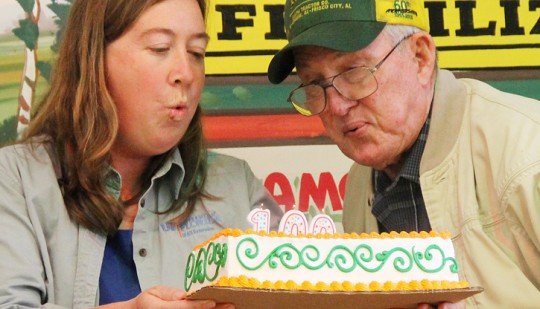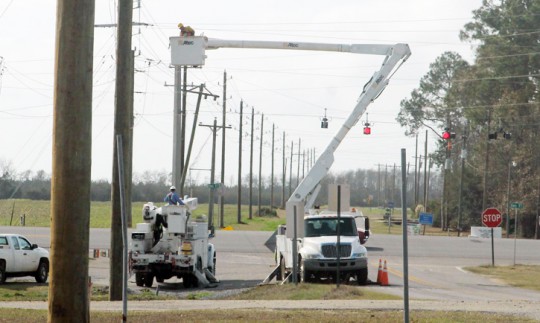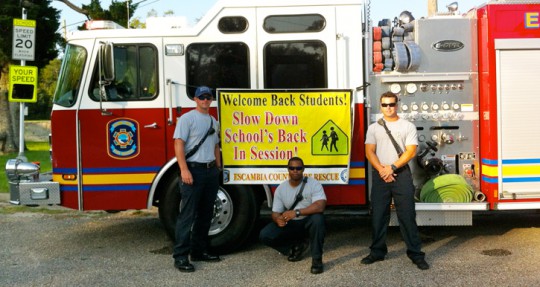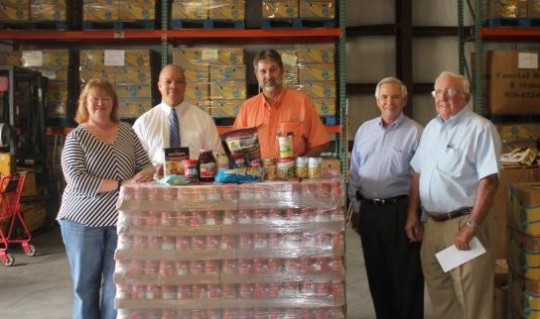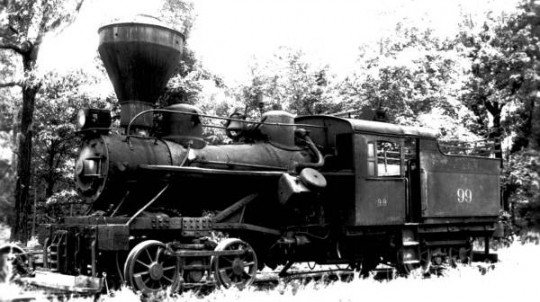Celebrating 100 Years: Extension’s Role In The Community
September 1, 2014
For 100 years, the University of Florida’s Institute of Food and Agricultural Sciences (UF/IFAS) Extension program has been enhancing and sustaining the quality of life by making university research accessible to the public.
UF/IFAS Extension is a federal-state-county partnership dedicated to developing knowledge in agriculture, human and natural resources, and the life sciences. UF/IFAS has a reputation for excellence in teaching and research on the university campus, which is extended into every community in the state through county extension offices. The local branch of UF/IFAS is typically referred to as “extension,” with “extension agents” tasked with carrying out educational programs.
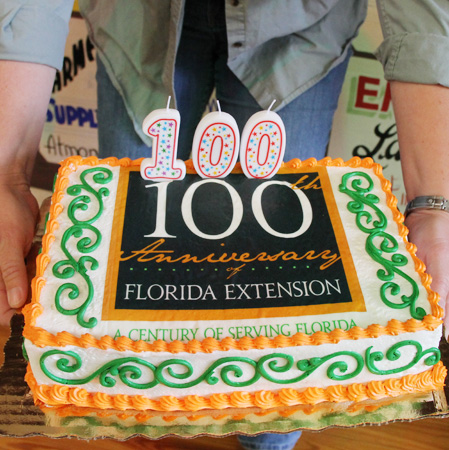 Since inception, the Escambia County extension agents have translated research from the UF campus into useful instruction for members of the community, taking a highly engaging approach to learning. For example, natural resource agents lead clientele in kayaking trips over seagrass beds to teach them about coastal ecology, while the agriculture agent hosts a biannual farm tour for elected officials. Horticulture agents teach physically and intellectually challenged youth to grow vegetables in a wheelchair accessible garden, while 4-H youth learn legislative procedure at mock sessions in the state capital.
Since inception, the Escambia County extension agents have translated research from the UF campus into useful instruction for members of the community, taking a highly engaging approach to learning. For example, natural resource agents lead clientele in kayaking trips over seagrass beds to teach them about coastal ecology, while the agriculture agent hosts a biannual farm tour for elected officials. Horticulture agents teach physically and intellectually challenged youth to grow vegetables in a wheelchair accessible garden, while 4-H youth learn legislative procedure at mock sessions in the state capital.
Customer service surveys performed in 2012 indicated 96% of residents who used Escambia County Extension were satisfied with their experience, and 90% of walk-in clientele said the information they received answered their questions or solved their problem.
Annually, Escambia County Extension agents train over 700 volunteers to further the reach of our educational efforts, with a total contribution (in 2012) of 54,035 hours valued at $983,437. Individuals in classes and workshops return to Extension time after time, due to the agents’ ability to utilize relationships with UF and local community members to provide targeted, science-based information through creative teaching methods.
ll of these efforts promote the advancement of agriculture, natural resources and sustainable economic development in Escambia County. Program area advisory committees, comprised of local citizens, assure that programs meet community needs.
Pictured top: Escambia County Extension Agent Carrie Stevenson and 4-H caretaker Ellis Miller blow out the candles on a 100th birthday cake for Escambia Extension. NorthEscambia.com file photos, click to enlarge.
Cotton Transition Assistance Program Enrollment Underway
August 31, 2014
Farmers can enroll in the Cotton Transition Assistance Program (CTAP) beginning through October 7.
The program, created by the 2014 Farm Bill, provides interim payments to cotton producers during the 2014 crop year until the Stacked Income Protection Plan, a new insurance product also created by the legislation, is available. Details on the plan will be released by mid-August.
CTAP applications approved before Oct. 1, are subject to Congressionally mandated automatic reductions of 7.2 percent for the 2014 crop year. Applications approved after October 1 will be reduced the required 7.3 percent for the 2015 crop year. The Budget Control Act of 2011 requires USDA to implement these reductions to program payments.
For more information about CTAP, visit a local FSA office or go online to www.fsa.usda.gov.
NorthEscambia.com file photo.
Sunny Days: Growing Sunflowers
August 31, 2014
by the Santa Rosa Extension Service
Sunflowers not only make the garden beautiful but can also be used to bring the beauty of outdoors inside.
It may be towards the end of summer, but you can still plant sunflowers and enjoy them during the fall. In north Florida, try to complete sunflower planting by the third week in August. Depending on the variety, sunflowers will bloom about 55 to 75 days after planting – 60 days is a good average. Some sunflowers are sensitive to day length and may yield shorter plants and earlier bloom when planted in late summer. This corresponds to the reduction in daylight hours as summer progresses toward autumn.
To begin, choose cultivars that fit your landscape. There are now more sunflowers than just the seed bearing giants that many gardeners are familiar with. Just take a look at the gardening catalogs.
 Sunflowers can be broadly divided into two types: those grown for production of edible seeds and those grown as ornamentals and cut flowers. Most gardeners will be interested in the ornamental sunflowers, also known as Helianthus annuus.
Sunflowers can be broadly divided into two types: those grown for production of edible seeds and those grown as ornamentals and cut flowers. Most gardeners will be interested in the ornamental sunflowers, also known as Helianthus annuus.
Sunflowers come in heights ranging from less than one foot to ten feet and also come in a wide range of flower colors. While brilliant yellow will always be popular, you can also choose from creamy white, bronze, mahogany, rusty red, burgundy and orange. Some types produce flowers with more than one color. The center disk of the sunflower also adds to the display and goes through color changes as the flower matures and seeds form.
Sunbright, Sunrich Lemon, Sunrich Orange, Soraya and Moulin Rouge are some that are recommended for Florida.
For best bouquet results, choose cultivars that are pollen-less to prevent pollen from shedding onto a tablecloth or other flowers in an arrangement.
If you want to grow sunflowers for the delicious, nutritious seeds, make sure you choose varieties bred for seed production, such as Mammoth Russian – also known as Mammoth, Russian Giant and Gray Stripe. These tall-growing sunflowers produce a single enormous flower at the top of the plant. To grow a really big seed head, apply general-purpose fertilizer when the flower head begins to appear. Just be sure to place them so that you can stake them if necessary.
 Sunflowers are true to their name, they need to be grown in full sun. Prepare a sunflower bed as you would for planting most vegetables. They tolerate heat and dry conditions and almost any soil type. The pH preference is 6.5 to 7.5 and the addition of composted organic matter is beneficial.
Sunflowers are true to their name, they need to be grown in full sun. Prepare a sunflower bed as you would for planting most vegetables. They tolerate heat and dry conditions and almost any soil type. The pH preference is 6.5 to 7.5 and the addition of composted organic matter is beneficial.
Plant seeds about one-quarter inch deep directly into a prepared garden bed. It’s common to plant sunflowers into landscape beds, and many gardeners include a row of sunflowers in spring and fall vegetable gardens. After sowing the seeds, water the bed well and thesun water it as needed to keep the soil moist – even lightly every day if the weather is dry.
Sunflowers should be harvested in early morning before 10:00 a.m. It is best to cut the stems and place them in warm water right away for best results.
The versatility and variety of today’s sunflowers offer something for almost every garden and gardener. If you haven’t tried this plant lately, give it another look.
Theresa Friday is the Residential Horticulture Extension Agent for Santa Rosa County.
Pack A Better School Lunch
August 31, 2014
by Dorothy Lee, Escambia County Extension
It’s that time of year again. With kids off to school they are again faced with the important question: What’s for lunch? With childhood obesity on the rise, having a nutritious lunch is an important part of an overall healthful diet. Since most kids consume one-third of their daily total calories at lunch, here are some tips on helping them eat more super-nutritious foods:
- Plan ahead. It helps to have all the right ingredients on hand for making the best lunch. You might even consider coming up with a weekly menu. Involve the kids in planning whenever possible.
- Avoid last-minute rushing by preparing all or part of lunch the night before.
- Use cookie cutters to make fun shapes with sandwiches, etc.
- Make sure you always include at least one fresh fruit or vegetable – both is even better.
- Hide special notes or cards in the lunch box.
- Best beverage bets include skim milk, water or 100% fruit juice.
- Try to use more low-fat snack and cookie items – see the list below for ideas.
- Remember food safety. It is better if you keep foods chilled in insulated lunch boxes with either an ice pack or frozen juice box.
And consider options when choosing ingredients for lunches:
Dorothy C. Lee, CFCS, is an Extension Agent, Family & Consumer Sciences with the Escambia County Extension Service.
10 Years After Arriving In America, New Citizen Votes For The First Time
August 27, 2014
Ten years to the day since Cesar Gonzalez came to America from Colombia, South America, he voted in his first election Tuesday in Century.
Gonzalez became a naturalized citizen on November 9, 2012, and registered to vote in the lobby of the courthouse immediately following the ceremony. Tuesday he showed his identification, just like every other U.S. citizen, and cast his vote at Precinct 22, the Century Town Hall.
His path to citizenship took seven years. Gonzalez was already a permanent resident, so the only tangible benefit he received with his citizenship was the right to vote. He and his wife, Century Town Clerk Leslie Gonzalez, moved to Century in 2010.
Photo for NorthEscambia.com, click to enlarge.
Lineworker Appreciation Day Was Tuesday
August 26, 2014
When Robert Duke was growing up in the Pensacola area, he spent a lot of time at a restaurant where Gulf Power linemen would come eat for lunch.
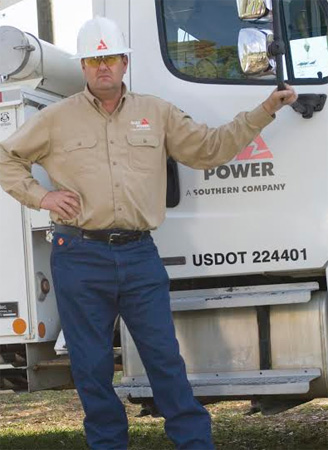 “I would talk to them a lot,” he said. “Then after Hurricane Frederick (in 1979), they came and worked in our yard. I got pumped up and said, ‘Man, I’m going to be a lineman one day.’”
“I would talk to them a lot,” he said. “Then after Hurricane Frederick (in 1979), they came and worked in our yard. I got pumped up and said, ‘Man, I’m going to be a lineman one day.’”
Duke has been a lineman for Gulf Power for almost 27 years. As the state honors lineworkers across the state on Tuesday, August 26 with Lineworker Appreciation Day, Duke is proud that line crews are being recognized for the work they do to keep customer’s lights on.
“You’re in the field every day and not in the same place,” he said. “We work in the heat and sometimes it’s hard on your body. But it’s a good feeling knowing you are getting people’s lights on when they’re in a bind. That’s a big reward.”
Gulf Power is proud to salute its lineworkers, who work tirelessly to keep Northwest Florida’s electricity flowing.
“Gulf Power crews do a great job of keeping the lights on — but they’re often called away from their families to work nights and holidays to restore power following storms or traffic accidents for example,” said Wendell Smith, Gulf Power vice president of Power Delivery. “These men and women are truly heroes and this day is to honor them.”
Gulf Power has approximately 175 employees who work on the company’s transmission and distribution lines, which total more than 9,300 miles.
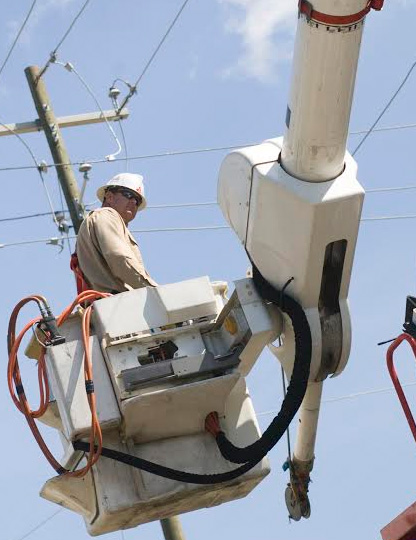 They have been especially busy this year in addition to their regular duties. Many were called away from their families in February during the ice storm in Pensacola and again in April when the floodwaters hit. In both events, they were able to restore power in less than 48 hours while working in hazardous conditions.
They have been especially busy this year in addition to their regular duties. Many were called away from their families in February during the ice storm in Pensacola and again in April when the floodwaters hit. In both events, they were able to restore power in less than 48 hours while working in hazardous conditions.
In 2012, the state Legislature made August 26 Lineworker Appreciation Day in Florida. It was created through the efforts of lawmakers and Tracy Moore, the widow of a Lakeland lineman, who was killed while working.
Part of Gulf Power’s mission is to lend assistance to other companies when natural disasters knock power out to hundreds of thousands of customers. Earlier this year, Gulf Power sent lineworkers to assist its sister company Georgia Power for a week following an ice storm. In 2013, Gulf Power sent crews out of state to assist other utilities on two different occasions. One of those was a trip to Alabama in March following a series of tornadoes. In December, crews worked to restore power in the Dallas area following an ice storm.
“Our award-winning lineworkers are committed to keeping the lights on, whether here in Northwest Florida or across the country,” Smith said. “That’s what they do and we’re proud they are being recognized for their efforts.”
NorthEscambia.com and submitted photos, click to enlarge.
Escambia Firefighters, EMS Crews Work To Keep School Zones Safe
August 25, 2014
Escambia County Fire Rescue and Escambia County EMS units were in school zones across the county with lights flashing as a reminder to drivers to slow down during the first week of school. In an email to NorthEscambia.com, Jim Allen Elementary School offered a special thanks to the crew of Escambia Fire Rescue Engine 4 (pictured) in Cantonment for slowing down the traffic on Highway 95A to help keep students safe. Photo for NorthEscambia.com, click to enlarge.
Escambia, Santa Rosa Farm Bureaus Donate 1.5 Tons Of Peanut Butter To Manna
August 25, 2014
The Florida Peanut Producers and the Farm Bureau in Escambia and Santa Rosa counties teamed up to donate one and a half tons of peanut butter to the Manna Food Bank.
 After discussing the flood that damaged the Manna warehouse and food supply, the Escambia County Farm Bureau voted to spend $1,000 to buy peanut butter, Manna’s most needed item. The Santa Rosa County Farm Bureau board then voted to donate $1,001 toward the peanut butter donation.
After discussing the flood that damaged the Manna warehouse and food supply, the Escambia County Farm Bureau voted to spend $1,000 to buy peanut butter, Manna’s most needed item. The Santa Rosa County Farm Bureau board then voted to donate $1,001 toward the peanut butter donation.
When notified of the purchase of peanut butter, the board of directors of Florida Peanut Producers and Ken Barton, executive director and agreed to match the purchase and donated a pallet of peanut butter.
With the two counties cooperation and the match from the Florida Peanut Producers, the total number of peanut butters jars donated will be 2,880. The second of two pallets of Peanut Proud peanut butter is expected to ship later in August to complete the donation.
Church Takes Cardboard Testimonies Highway 29, Sharing Stories Of Faith
August 24, 2014
They say a picture is worth a thousand words. But a few words on piece of plain brown cardboard can tell a life story and story of faith in a way a thousands words could not touch.
The concept is simple. A piece of cardboard. A permanent marker. On the first side of the cardboard for all to see is the story of a sin, a trial, a struggle or battle. On the flip side is where the person stands today though Christ.
“I was broken and tried to kill myself,” read one side of a piece of cardboard a woman stood holding alongside Highway 29. “But God made me whole!”
Her “cardboard testimony” was one of dozens from CrossFaith Church in Molino at the Highway 29 and Muscogee Road intersection in Cantonment Saturday morning. The biggest challenges, hurts, and prayers of a lifetime condensed into seconds for passing traffic on plain cardboard.
“I was a womanizer, a[n] adulterer, drug user, acholic [sic], dealer, verbally abusive,” tough words for a grown man to admit on one side of his sign. The other: “God cleansed and set me free.”
For a photo gallery with more CrossFaith Church cardboard testimonies, click here.
Photos for NorthEscambia.com, click to enlarge.
Looking Back: Escambia Railway Engines In 1942
August 24, 2014
Here are two photographs of Escambia Railway engines that were taken 72 years ago this weekend. The Escambia Railway was operated by Alger-Sullivan Lumber Co. in what is now present day Century.
The above photograph — taken in Century on August 23, 1942, shows Escambia Railway Engine Number 99. It was bought new and purposed as a woods logging engine. It was damaged in 1922 by a boiler explosion caused by low water, killing the fireman. It was repaired and returned to service. Engine Number 99 was retired in 1945 and scrapped in May 1957.
Below is Escambia Railway Engine Number 96, photographed in Century on August 23, 1942. The engine was formerly the T.R. Miller Mill Co. #7 and was used as a woods logging engine. It was retired sometime prior to 1945 and scrapped in April 1957.
Photos courtesy the State Archives of Florida.


